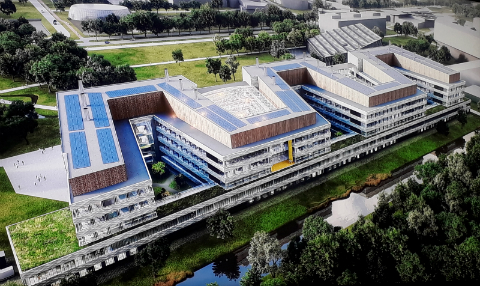Contracts for the building’s other elements (equipment and laboratories) are being finalised, vice president of the board of directors Jan de Jeu says. De Jeu updated the university council on the Feringa Building plans on Thursday.
It will replace the outdated Nijenborgh 4, which has housed the physics and chemistry departments on the south-east side of the Zernike terrain since 1969. ‘That building has lasted for a really long time, but it’s getting creaky and it’s ridden with asbestos’, De Jeu explains.
Screwed
The first foundation posts will be placed this summer. These will be screwed in rather than driven in, in an effort to disturb the research being done in the surrounding buildings as little as possible. Phase 1 of the construction should be finished in the second half of 2021; staff members currently working in sections 17 and 18 of Nijenborgh will then be able to move.
Phase 2 will start early in 2022 and should be finished in the summer of 2023. The rest of Nijenborgh 4 will then be able to move to the new building, after which the former will be demolished. At least, partly demolished; some sections of Nijenborgh 4 may remain. ‘That’s not been definitely decided yet. It depends on the needs of the university, in terms of space’, says De Jeu.
The RUG has seen a steady increase in student numbers over the past few years, which has led to a lack of room at the Faculty of Science and Engineering. If the rise of student numbers persists, the new Feringa Building might not even be big enough to accommodate all the staff and students.
Three kilometres of lab tables
The building will, in fact, be quite big: 260 metres by 63 metres, with a total floor space of 64,000 square metres. That’s twice as big as the other science faculty building, the Linnaeusborg.
‘We’ll have a hallway that spans the entire front of the building, connecting all the different sections’, De Jeu explains. Seating areas and work stations for students will be constructed along the hallway. All the logistics will be located in a similar hallway at the back of the building.
In an effort to minimise the effects of the erratic Dutch weather, all the laboratories in the building will face north. The plans also include a lecture hall with room for 420 people (or two halls with room for 180 and 240 people, respectively); a restaurant with 250 seats; four inside garden, a conference hall, thirty laser labs, three kilometres worth of lab tables, and 450 fume hoods.
250 million euros
The fume hoods, as well as the entire building, will be energy-efficient. Heating the building will not be done through the use of gas, but through a system that pumps up hot and cold groundwater. The roof will have solar panels and insulation will be ‘as optimal as possible’, according to De Jeu.
The Feringa Building will set the RUG back approximately 250 million euros. The university hopes the building will last at least fifty to sixty years.




